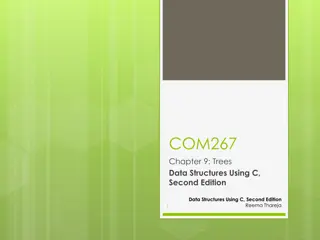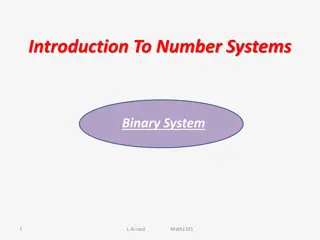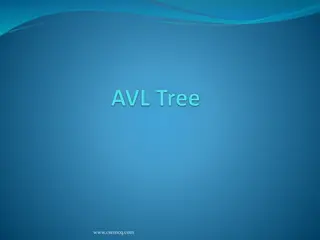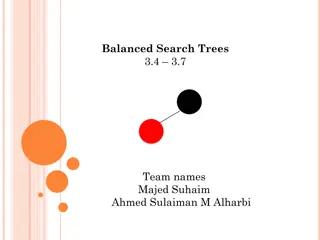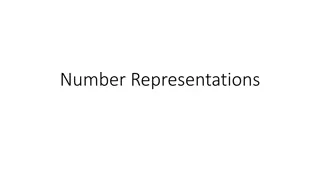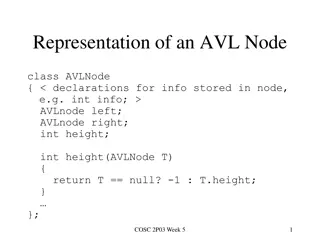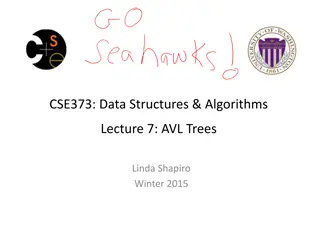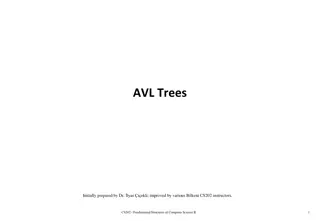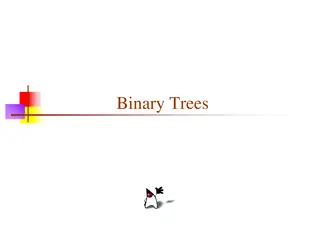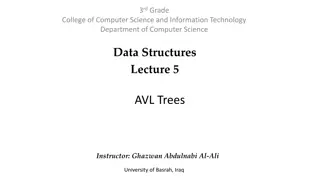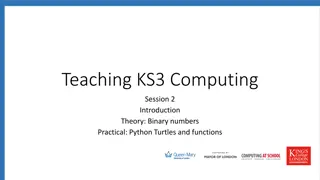Introduction to Binary Search Trees and AVL Trees
Binary Search Trees (BST) and AVL Trees are essential data structures in computer science, providing efficient ways to store and retrieve data. A BST follows specific rules for node placement, while an AVL tree ensures balance for faster operations. Discover the characteristics, limitations, and benefits of these trees through real-world examples. Learn about skewed BSTs, the importance of balance factors, and the intricacies of maintaining balance in AVL trees.
Download Presentation

Please find below an Image/Link to download the presentation.
The content on the website is provided AS IS for your information and personal use only. It may not be sold, licensed, or shared on other websites without obtaining consent from the author.If you encounter any issues during the download, it is possible that the publisher has removed the file from their server.
You are allowed to download the files provided on this website for personal or commercial use, subject to the condition that they are used lawfully. All files are the property of their respective owners.
The content on the website is provided AS IS for your information and personal use only. It may not be sold, licensed, or shared on other websites without obtaining consent from the author.
E N D
Presentation Transcript
Binary Search Tree(BST) AVL Tree 1
Binary Search Tree (BST) Binary Search Tree, is a binary tree data structure which has the following properties: The left subtree of a node contains only nodes with values lesser than the node s value. The right subtree of a node contains only nodes with value greater than the node s value. The left and right subtree each must also be a binary search tree. There must be no duplicate nodes. 2
Skewed BST If a tree which is dominated by left child node or right child node, is said to be a Skewed Binary Tree. In a left skewed tree, most of the nodes have the left child without corresponding right child. In a right skewed tree, most of the nodes have the right child without corresponding left child. 4
Limitation of BST The average search time for a binary search tree is directly proportional to its height: O(h). Most of the operation average case time is O(log2n). BST s are not guaranteed to be balanced. It may be skewed tree also. For skewed BST, the average search time becomes O(n). So, it is working like an linear array. To improve average search time and make BST balanced, AVL trees are used. 5
AVL Tree AVL tree is a height balanced tree. It is a self-balancing binary search tree. It was invented by Adelson-Velskii and Landis. AVL trees have a faster retrieval. It takes O(logn) time for insertion and deletion operation. In AVL tree, difference between heights of left and right subtree cannot be more than one for all nodes. 6
AVL Tree Balance Factor of node is: Height of left subtree Height of Right subtree Balance Factor is calculated for every node of AVL tree. At every node, height of left and right subtree can differ by no more than 1. For AVL tree, the possible values of balance factor are -1, 0, 1 Balance Factor of leaf nodes is 0 (zero). 7
Example Every AVL Tree is a binary search tree but all the Binary Search Tree need not to be AVL trees. BST and AVL BST but not AVL 8
Finding Balance Factor BF= hl - hr 9
Height of AVL Tree By the definition of complete trees, any complete binary search tree is an AVL tree Thus, an upper bound on the number of nodes in an AVL tree of height h a perfect binary tree with 2h + 1 1 nodes. What is a lower bound? 10
Height of AVL Tree Let F(h) be the fewest number of nodes in a tree of height h. From a previous slide: F(0) = 1 F(1) = 2 F(2) = 4 Then what is F(h) in general? 11
Height of AVL Tree The worst-case AVL tree of height h would have: A worst-case AVL tree of height h 1 on one side, A worst-case AVL tree of height h 2 on the other, and The root node We get: F(h) = F(h 1) + F(h 2) + 1 This is a recurrence relation: = 1 0 h = = F( ) 2 1 h h + + F( ) 1 F( ) 2 1 1 h h h 12
Imbalance After an insertion, when the balance factor of node A is 2 or 2, the node A is one of the following four imbalance types 1. LL: new node is in the left subtree of the left subtree of A 2. LR: new node is in the right subtree of the left subtree of A 3. RR: new node is in the right subtree of the right subtree of A 4. RL: new node is in the left subtree of the right subtree of A 13
AVL Tree Example Insert 14, 17, 11, 7, 53, 4, 13 into an empty AVL tree 14 14 11 17 7 17 7 53 4 11 53 4 13 14
Types of Rotation Rotation- To switch children and parents among two or three adjacent nodes to restore balance of a tree. LL Rotation Single Rotation RR Rotation Rotation LR Rotation Double Rotation RL Rotation 15
Types of Rotation Single Rotation is applied when imbalanced node and child has same sign of BF (in the direction of new inserted node). LL Rotation is applied in case of +ve sign. It mean left tree is heavy and so LL rotation is done. RR Rotation is applied in case of -ve sign. It mean right tree is heavy and so RR rotation is done. Double Rotation is applied when imbalanced node and child has different signs of BF (in the direction of new inserted node). 16
LL Rotation Insert 3,2,1 in AVL Tree L L Imbalanced AVL Tree LL Rotation Balanced AVL Tree 17
RR Rotation Insert 1,2,3 in AVL Tree R R Imbalanced AVL Tree RR Rotation Balanced AVL Tree 18
LR Rotation Insert 3, 1, 2 in AVL Tree L R RR Rotation LL Rotation Balanced AVL Tree Imbalanced AVL Tree 19
RL Rotation Insert 1, 3, 2 in AVL Tree R L Balanced AVL Tree LL Rotation RR Rotation Imbalanced AVL Tree 20
Construct a AVL Tree by inserting from 1 to 5 numbers -1 -2 1 1 0 1 2 3 -1 2 2 0 0 3 Not AVL Apply RR Rotation 21
Construct a AVL Tree by inserting from 1 to 5 numbers -1 -2 2 2 0 2 4 5 -1 -2 0 1 3 1 3 0 1 3 0 0 0 -1 4 4 After Rotation 0 5 22
Construct a AVL Tree by inserting from 1 to 5 numbers -1 2 0 4 1 0 0 5 3 0 AVL Tree 23
Construct AVL Tree with data items: 51, 26, 11, 6, 8, 4, 31 24
Insertion in AVL Tree Insert 2 LL Rotation 25
Insertion in AVL Tree Insert 4 LR Rotation (3, 5, 6) 26
Deletion in AVL Tree It is also possible to delete an item from AVL Tree. Delete 8 Balanced AVL Balanced AVL 27
Deletion in AVL Tree Just like insertion, deletion can cause an imbalance, which will need to be fixed by applying one of the four rotations. R1 Rotation Delete 8 Balanced AVL Imbalanced AVL 28
Deletion in AVL Tree The deletion is also the same as in BST. However, in imbalanced tree due to deletion, one or more rotations need to be applied to balance the AVL tree. The Right(R) imbalance is classified into R0, R1, R-1 The Left(L) imbalance is classified into L0, L1, L-1 29
Deletion in AVL Tree LL Rotation is same to R0 and R1 RR Rotation is same to L0 and L-1 LR Rotation is same to R-1 RL Rotation is same to L1 30
R0 Rotation (+1) A (+2) A Deletenode X (0) B (0) B AR AR h x h h h-1 BL BR BL BR Unbalanced AVL search treeafter deletion of node x
R0 Rotation (+2) (-1) B A (+1) A (0) R0 Rotation B AR BL h AR h BF(B) == 0,use R0 rotation BR BL BR Unbalanced AVL search treeafter deletion of x Balanced AVL search treeafter rotation
R0 Rotation Example (+1) 46 (+2) 46 (-1) (0) (0) (0) Delete60 20 54 20 54 (+1) (0) (+1) 23(-1) (-1) 18 60 18 23 (0)24 (0) (0)24 7 (0) 7 Unbalanced AVL search treeafterdeletion
R0 Rotation Example (+2) 46 (-1) 20 (0) (0) (+1) (+1) R0 20 18 54 46 (+1) (0) 23(-1) (-1) (0) 54 18 23 7 (0)24 (0) (0)24 7 Balanced AVL search tree afterdeletion
R1 Rotation (+1) A (+2) A Deletenode X (+1) B (+1) B hAR x h -1 AR h BL h BL h-1 h-1 BR BR Unbalanced AVL search tree after deletionof nodex
R1 Rotation (+2) (0) B A (0) A (+1) B R1Rotation AR h -1 BL h-1 A h BF(B) == 1,use R1 rotation h-1 R BR BL BR Balanced AVL search treeafter rotation
R1 Rotation Example (+1) 37 (+2) 37 (+1) (+1) (0) (+1) Delete39 26 41 26 41 (+1) 39 (0) (+1) 28 (0) 18 18 28 (0) (0) 16 (0) 16 Unbalanced AVL tree afterdeletion search
R1 Rotation Example (+2) 37 (0) 26 (0) (+1) (0) (+1) R1Rotation 26 41 18 37 (+1) (0) (0) 28(0) 28 (0) 18 41 16 (0) 16 Balanced AVL search tree afterdeletion
R-1 Rotation A (+1) (+2) A (-1) B (-1) B (0) C DeleteX h-1 C(0) h h-1 AR BL x CR CL BL CL CR AR Unbalanced AVL search treeafter deletion
R-1 Rotation A (+2) (+2) A (+1) (-1) B C h-1 (0) R-1 B C(0) h-1 CR AR BF(B) ==-1, use R-1rotation BL CL BL CL CR AR
R-1 Rotation (0) C (0) B (0) A h-1 R-1 h-1 (0) CL BL CR AR Balanced AVL search treeafter Rotation
R-1 RotationExample (+1) 44 (+2) 44 (0) (-1) (-1) (-1) Delete52 22 22 48 48 (0) (0) 28(0) 28(0) 52 18 18 29 29 (0) 23 23 Unbalanced AVLsearch tree afterdeletion
R-1 RotationExample (+2) 44 (+2) 44 (0) (-1) (-1) (+1) R-1 Rotation 22 28 48 48 (0) (0) 28(0) 29(0) 18 22 (0) 29 (0) 23 23 18 Unbalanced AVLsearch tree afterdeletion
R-1 RotationExample (0) 28 (0) 44 (0) 22 (0) (0) (0) 23 48 18 29 Balanced AVL searchtree afterrotation
L0 Rotation (-1) A (-2) A Delete X (0) (0) B h-1 B h AL h h x AL BL BR BL BR Unbalanced AVL search treeafter deletion
L0 Rotation (-2) A (+1) B L0 Rotation (0) (0) B (-1) ALA h -1 h BR h h-1 AL BL BR BL Balanced AVL search treeafter deletion
L0 Rotation (-1) (-2) Delete 22 48 48 44 44 (1) (0) 52 (0) 52 (0) 54 54 22 (-1) (-1) (0) (1) 50 50 (1) (0) 56 56 (0) (0) 49 (0) 49 47
L0 Rotation (1) 52 L0 Rotation 54 (-1) 48 (-1) 56 (0) 44 50 (0) (1) 49 (0) 48
L1 Rotation (-1) A (-2) A (+1) Delete X (+1) B h-1 B h AL (0) (0) h-1 C h-1 x C A B BR L R h-1 CL CR Unbalanced AVL C CL search treeafter deletion R
L1 Rotation (-2) A (0) C (0) (0) L1 Rotation (+1) B B h-1 A (0) h-1 h-1 C h-1 AL B BR R C h-1 CL AL R Unbalanced AVL search treeafter deletion C CL R



